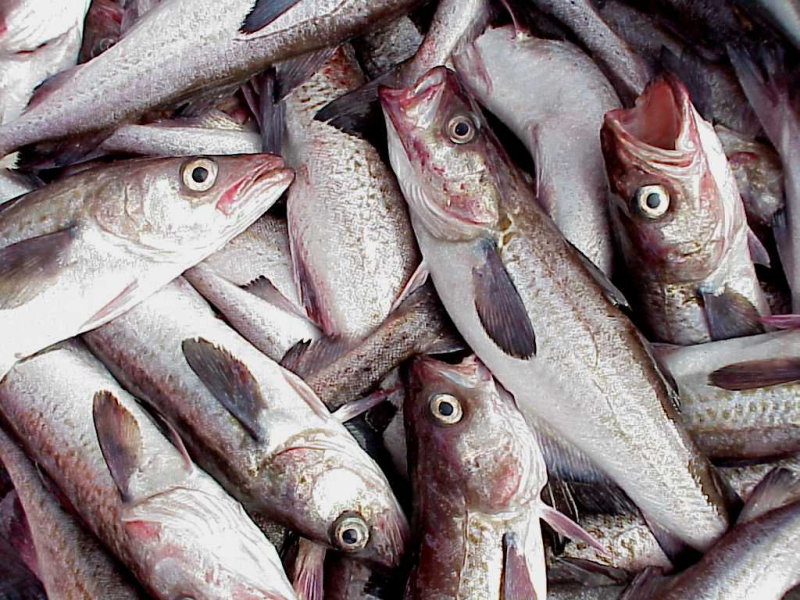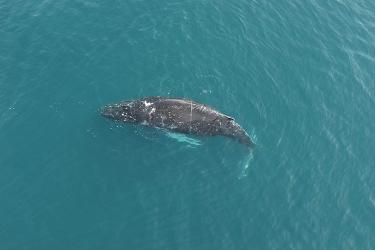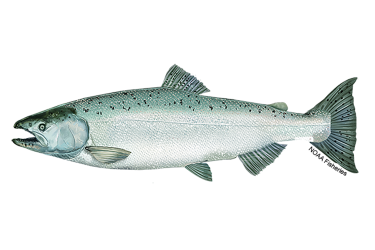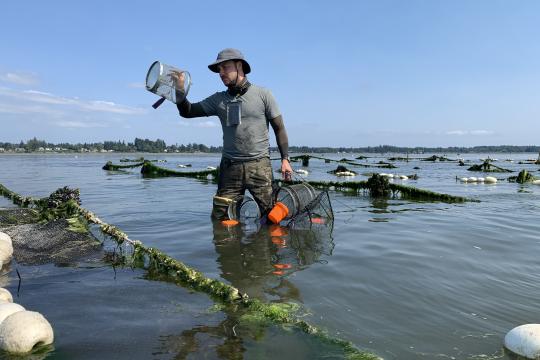Ecosystem-based fisheries management (EBFM) has been applied in Alaska for decades with great success. Alaska’s valuable commercial fisheries are among the most productive and sustainable in the world. However, current EBFM policies were not designed to address climate change.
A 2020 study evaluates the future performance of EBFM in the eastern Bering Sea. The innovative experiment projects that EBFM can forestall climate-driven collapse of key Alaska fisheries better than other management policies. This management approach considers the impacts on fish stock productivity from environmental variables, such as changing ocean conditions, and socio-economic factors. It can help fishery managers and fishermen in planning for the future.
“Ecosystem-based management doesn’t just help fish, it helps fishing communities. It is the best strategy we have to provide harvest stability in the coming years. It buys time for Alaska fisheries and fishing communities to prepare and adapt. EBFM is going to be a vital tool for us under climate change,” said Kirstin Holsman, biologist at NOAA Fisheries’ Alaska Fisheries Science Center. “But no matter how effective management is, by mid-century—maybe sooner—Alaska fisheries may reach a tipping point of rapid decline in the eastern Bering Sea if climate change continues on the current trajectory and fish and fisheries are not able to adapt to these changing conditions. To guarantee long-term success, we need to couple EBFM with global climate change mitigation.”
Alaska at the Forefront of Change
EBFM is a holistic approach that looks at the entire ecosystem, including human activities. For example, if a particular species’ population were declining, fishery managers might decide to reduce the annual catch limit the following year in an attempt to reduce its mortality from fishing. But fishing is only one variable that affects a species’ population—additional elements come into play. They could include interactions with other species, the effects of environmental changes, or pollution and other stressors on habitat, water quality, and changing climate.
EBFM ensures that fishery managers consider these additional elements to more effectively assess the health of any given fishery. Then, they can determine the best way to maintain it. Through EBFM, NOAA Fisheries’ goal is to maintain healthy, resilient ecosystems that support multiple productive fisheries.
The eastern Bering Sea supports some of the largest and most valuable fisheries in the United States. These fisheries have operated under one of the world’s most well established and successful examples of EBFM for more than three decades. A key feature of the policy is an overarching 2 million metric ton annual total allowable catch limit. This is a cap on all the groundfish species caught in the eastern Bering Sea. It was implemented in 1984 to achieve optimal yield and preserve ecosystem function.
“Very few places outside of conservation areas are using ecosystem-based management. Applying it to fisheries on this large of a scale is unique to Alaska. Other regions are moving toward it, but Alaska has been leading the way for decades,” Holsman said.
Current EBFM in the Bering Sea has sustained high fisheries yield over the last three decades. There have been few instances of stocks in an overfished condition, despite climate variability during that time. However, it is yet untested against the magnitude of environmental change anticipated under future climate change.
We have had a glimpse at what future conditions may look like in recent warm years. Alaska ecosystems and communities have been on the forefront of climate change impacts. Vanishing sea ice and unprecedented heating set in motion a rapid transformation of Alaska marine ecosystems. Populations of some commercially valuable fish have responded with large-scale northward expansions in recent years. During the winter of 2019-2020, conditions were closer to past normal conditions.
“We have witnessed unprecedented changes in the ecosystem recently. Will our cutting-edge tools for management be enough to cope with climate change? Can we stay the course and be OK? If not, how much time do we have?” said Holsman.
Predicting the Future of Bering Sea Fisheries
These questions spawned an unprecedented experiment, and a multidisciplinary team of scientists joined forces. They wanted to understand how fish populations, the ecosystem, managers, the fishing industry, and the social system might interact and respond to changing environmental conditions.
The team included scientists from the Alaska Fisheries Science Center, the Pacific Marine Environmental Laboratory, and the University of Washington’s School of Aquatic and Fishery Sciences.
Scientists projected scenarios to assess the future performance of EBFM policies as implemented in the eastern Bering Sea for the past two decades.
“This multi-agency partnership serves as a pioneering case study for how agencies across NOAA and academia can conduct climate-fisheries research,” said Anne Hollowed, co-author and fisheries scientist at the Alaska Fisheries Science Center.
The study is part of NOAA Fisheries’ Alaska Climate Integrated Modeling (ACLIM) project. ACLIM is a comprehensive, multi-year, interdisciplinary effort to project climate-driven changes to the eastern Bering Sea ecosystem, from physics to economics. It also seeks to understand how fisheries management can sustain fish populations and help fisheries and communities adapt to these changes.
Specifically, this study evaluated whether EBFM:
- Reduces future risk of Alaska commercial species catches and fish population declines
- Provides increased stability and sustainability in catches under climate change
“We designed this study with critical input from resource managers at the North Pacific Fishery Management Council and other stakeholders. We’ve worked hard to respond to the specific questions they asked about how management and the environment are likely to change,” said Alan Haynie, an economist at the Alaska Fisheries Science Center and co-author on the 2020 study.
According to Haynie, the project takes global climate change projections and applies them at the regional level to the Bering Sea ecosystem. “Through this innovative, interdisciplinary research we have produced a really exciting set of tools that we can continue to adapt and improve. We are able to show a measurable stabilizing effect of the 2 million metric ton cap on fisheries yield.”
In undertaking this project, scientists faced an enormous challenge. Uncertainty about ecosystem and global climate response means there is a huge range of possibilities for the future.
“There are so many scenarios,” said Holsman. “How do we look at that and see what we need to do today to help us weather that storm, to be ready in 50 years?”
A unique aspect of this study and modeling approach is that it includes the human response to changing environmental conditions. The model incorporates important socio-economic information on how fishery managers make cross-species allocations under the cap. It also analyzes how commercial fisheries respond to changes in their catch allocations. Projections are more realistic. The research sets a new standard for how interdisciplinary models should project future catches.
An Inclusive “Ecosystem” Modeling Approach
Climate, oceanography, food web shifts, fish population dynamics, management, and socioeconomic adaptations interact to create possible future scenarios. Scientists started by looking at two potential climate scenarios. The first included no mitigation; with the second, some mitigation occurred. Three global climate models were used as a basis for developing a more fine-scale regional model for the southeastern Bering Sea. This model produced regional projections for various indices (e.g., cold pool, bottom temperature, and zooplankton abundance) under each emission scenario.
This information was then incorporated into existing multi-species models. These models consider the relationships between various groundfish species. They are used to generate a target fishing mortality rate.
In the study, scientists then considered four possible approaches that the resource manager can take for managing commercial fisheries.
In the Bering Sea, for 35 years resource managers have practiced EBFM to effectively manage these fisheries. This entails the innovative use of a socio-economic model, individual species management measures and an overall limit on the total amount of biomass (average weight of all fish caught) that can be removed from the ecosystem to determine sustainable catch rates.
“Collaboration was critical to figuring this out,” said Holsman. “We have oceanographers, economists, climatologists, sociologists. The model doesn’t just stop with biology, but also explores how management responds. Considering management response is really important. We would have had a much more dire prediction without ecosystem-based management.”
The study focused on three key Alaska fisheries:
- Alaska pollock is the largest fishery in the United States.
- Pacific cod is one of the most economically valuable fisheries in the United States.
- Arrowtooth flounder is a key predator of pollock. Unlike Alaska pollock and Pacific cod, arrowtooth flounder has historically been harvested well below the maximum sustainable yield due to a lack of product development.
EBFM May Help Forestall Climate-Driven Decline
EBFM in the eastern Bering Sea has been an effective tool for maintaining consistently high catches and healthy fish populations in the eastern Bering Sea.
Through this effort, scientists also show that EBFM may help ensure fisheries sustainability under climate change in the near-term. Fisheries and fishermen will have a critical window of opportunity to prepare and adapt. Without EBFM, declines were projected for all species under climate change.
“It was exciting to take a close look at performance and discover that the EBFM policy put in place three decades ago really does impart stability to fisheries and the ecosystem,” said Holsman.
However, unless fish and fisheries are able to adapt or additional management measures are implemented, several projections showed that EBFM was insufficient to prevent a decline in pollock and cod catches by 2050, if summer temperatures near the seafloor in the Bering Sea warmed by ~0.2 °C.
Several model projections also showed the point where an 80 percent decline in catches could occur in the eastern Bering Sea. In these warmest scenarios, by 2075 the chance of pollock and Pacific cod catch declines was 70 percent and 36 percent, respectively, if fish and fisheries didn’t move. Current survey effort provides a glimpse of what may happen if this were to occur. Under recent sustained warm ocean temperatures in the southeastern Bering Sea, fish and fisheries have moved northward into the northern Bering and Chukchi Seas. This speaks to the importance of having both modeling and research surveys to understand the dramatic environmental changes in the ocean.
Model projections were more optimistic for less temperature-sensitive species. For example, arrowtooth flounder catch is projected to be stable and, in some scenarios, actually increases under climate change.
“There is considerable spread in these model projections of the 21st century Bering Sea. These result from the ‘natural’ chaos of global climate variability, from annual through decadal scales, as well as uncertainty among the different methods we use to model nature. Despite this spread, under a no-mitigation scenario, all three of the simulations predicted a warmer Bering Sea after 2050,” said Al Hermann, co-author and physical oceanographer with the University of Washington Cooperative Institute for Climate, Ocean and Ecosystem Studies. “Without climate mitigation, humankind’s influence on the temperature of the Bering Sea clearly outweighs natural variability and model uncertainty by the middle of this century.”
Future Predictions
In the next phase of ACLIM, scientists plan to take the research further by incorporating information on marine mammals, such as northern fur seals, and the subsistence communities who are dependent on them. They will also explore fish movements and human response.
“This will involve a lot more collaboration with communities, which will be really insightful, so we can better understand how people are adapting to changing environmental conditions,” said Holsman. “We want to preserve key management tools and develop others to promote stability, sustainably, and flexibility to adapt to climate driven change. Doing so allows us to collectively protect and promote the vital ecosystems of Alaska that support food and nutritional security of marine-dependent communities and the nation while maximizing fishing opportunities.”
Holsman sees opportunities in the future to show the world how effective EBFM is and to build on these efforts.
“Significant change is coming. We need to prepare for it. Proactive management like EBFM can buy us more time. We’re seeing that now, in weathering recent marine heatwaves that are a preview of what is to come. We still have commercially viable pollock and cod fisheries in the Bering Sea. EBFM is critical to near-term adaptation to climate change. We need to stay the course to ensure climate resiliency in fisheries.“
According to Hollowed, innovative new approaches will also be key. “Over the next three years, we will design and test climate-smart management approaches and assessment tools. We expect that our understanding will be accelerated by innovations in ecosystem-linked assessments. Technological advances, like expanded use of remote sensing and automated sampling, will also play a big role.”
This research is part of NOAA Fisheries’ Alaska Climate Integrated Modeling project (ACLIM) and the Alaska IEA program. The study is a collaborative effort between NOAA Fisheries’ Alaska Fisheries Science Center (K. Holsman, A. Haynie, A. Hollowed, J.C.P. Reum, K. Aydin, A. Faig, J. N. Iannelii, K. Kearney); the University of Washington School of Aquatic and Fishery Sciences (Holsman, Reum, Faig, A.E. Punt); the University of Washington Cooperative Institute for Climate, Ocean and Ecosystem Studies (A. J. Hermann, W. Cheng, Kearney); NOAA’s Pacific Marine Environmental Laboratory (A.J. Hermann, W. Cheng); and the University of Tasmania Institute for Marine and Antarctic Studies and Centre for Marine Socioecology (Reum).










